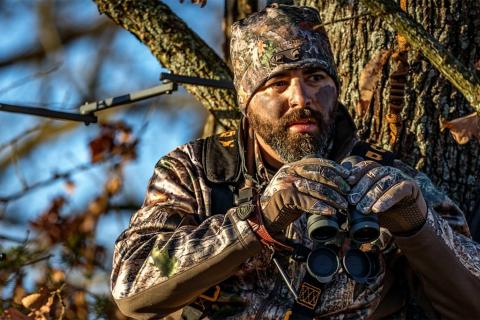
Whether you spend little money, medium money, or big money on binoculars, they will only perform as well as you know how to use them. If binoculars are to provide all-day comfort and critical fine detail needed to judge a trophy from an “almost,” you must adjust them properly.

Let’s pick a solid, mid-priced binocular model from Cabela's on which to focus such as the Cabela's Intensity HD 10X42 binoculars. That’s the most popular magnification and lens size for hunting these days. Like most binoculars, they are "center focus." The dial located between the two eye tubes adjusts the focus of both sides simultaneously when you turn it.
But too often overlooked is the diopter adjustment. This critical adjustment compensates for the difference in strength between your two eyes. Few people have exactly the same visual acuity with both eyes.
Eye Fatigue or Headaches & Getting the Sharpest View
If you experience eye fatigue or headaches after looking through binoculars, even for a short time, improper diopter adjustment is the cause. Setting the diopter is simple and fast, but it makes viewing through binoculars much more enjoyable and efficient. All you need are the objective lens covers and about two minutes of time out where you can see for 100 yards or more. Don’t sight through window glass as it dampens the clarity of quality lenses.
On some binoculars the diopter adjustment is a ring behind the right eyepiece. On some other binoculars, the center focus knob slides back or forward to become a single lens adjustment. Read the owner's manual or search online to determine the location of the diopter adjustment for your brand and model.
Click here to see a larger view of how to adjust the diopter setting on your binoculars.

6 Step-by-Step Instructions to Adjusting the Diopter on a Set of Binoculars
1. Pick an object at some intermediate distance such as 100 - 150 yards or so. It’s best to sight on something with good contrast and fine detail– like the dark, bare limbs at the top of a tree against the clear sky.
2. With the diopter adjustment on the right lens tube, place the lens cap to cover the right objective lens only.
3. Keeping both eyes open, adjust the center focus dial so you see those small tree limbs in perfect definition. Take your time. Be certain the adjustment is absolutely precise. Roll the dial past perfect focus in both directions, then settle back to the best view for you.
4. Keep looking at exactly the same object, and take your finger away from the center focus dial. Remove the lens cap from the right side and place it to cover the left objective lens.
5. Again, with both eyes open, carefully move the diopter adjustment ring back and forth (without touching the center focus) to find the sharpest possible view of the same object.
You're nearly done...
6. Remove the lens cap, and with both eyes open, look one more time at the same object. It should be in razor sharp focus. Now look at objects at varying distances. Use the center focus adjustment to bring them quickly into sharp view.
Some binoculars allow you to "lock" the diopter adjustment in place. Other's simply provide markings for you to note how many "hash marks" you are either plus or minus from zero. It’s a good idea to make a physical mark on the setting dial. A dot of White Out correction fluid half on the dial and half on the eye tube works well. That way if you loan the binoculars to someone else for a look and if they change the setting, you can quickly come back to the sweet spot for your eyes.
One other tip - especially from one season to the next - be sure to recheck the diopter adjustment. Eyes change over time, especially for well-seasoned hunters, so you may need to modify the setting from year to year.
- 12074 views

